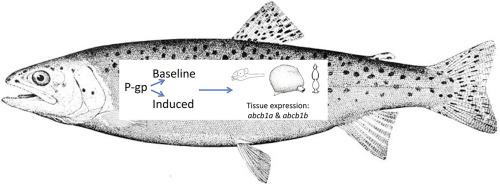Comparative Biochemistry and Physiology B: Biochemistry & Molecular Biology ( IF 2.2 ) Pub Date : 2020-11-21 , DOI: 10.1016/j.cbpb.2020.110538 Ryan C. Love , Heather L. Osachoff , Christopher J. Kennedy

|
P-glycoprotein (P-gp) plays a pivotal role in cellular defense, aimed at reducing xenobiotic accumulation. As a member of the ABC family of proteins, expression of this protein confers the multixenobiotic resistant (MXR) phenotype in aquatic organisms, including fish. To identify tissues protected by or contributing to the elimination of xenobiotics via P-gp, tissue-specific P-gp isoforms abcb1a and abcb1b transcript expression were measured in rainbow trout (Oncorhynchus mykiss). Tissues investigated included the proximal and distal intestines, liver, head kidney, gills, gonads, and 5 regions of the brain: olfactory lobe, cerebrum, optic lobe, cerebellum and medulla. Abcb1a transcript was more widely expressed across tissues and generally showed higher transcript expression than abcb1b. Deviation from this trend occurred in the gills, cerebrum and head kidney, where transcript levels were relatively equal between abcb1a and abcb1b. Intestinal tissues had greater abcb1a expression than abcb1b (3 orders of magnitude). Abcb1b was absent from liver tissue indicating that abcb1a is relied upon for hepatic defense. This study suggests that abcb1b acts to protect sensitive organs from compounds in the systemic circulation (brain and gonad), whereas abcb1a acts primarily in an elimination role in organs such as liver and intestine. To determine if P-gp induction alters transcript responses, the antifungal mammalian Pregnane-X-Receptor (PXR) agonist clotrimazole (CTZ) was used. CTZ-treated rainbow trout showed significantly increased abcb1b transcript expression in the optic lobe and distal intestine, providing evidence that trout PXR exhibits a similar substrate base as mammalian PXR, albeit selectively in regions of the brain and intestine.
中文翻译:

简短交流:克霉唑诱导后虹鳟(Oncorhynchus mykiss)中P-糖蛋白亚型abcb1a和abcb1b的组织特异性转录表达
P-糖蛋白(P-gp)在细胞防御中起着举足轻重的作用,旨在减少异源生物的积累。作为ABC蛋白质家族的一员,该蛋白质的表达赋予包括鱼类在内的水生生物多异生物抗性(MXR)表型。以识别由或促进生物异源物质的消除保护组织经由P-gp的,组织特异性的P-gp的同种型abcb1a和abcb1b虹鳟鱼测定转录物表达(虹鳟)。研究的组织包括近端和远端肠,肝,头肾,腮,性腺和大脑的五个区域:嗅叶,大脑,视神经叶,小脑和延髓。Abcb1a转录产物在组织中的表达更为广泛,通常表现出高于abcb1b的转录表达。与这种趋势的偏差发生在the,大脑和头肾,在abcb1a和abcb1b之间的转录水平相对相等。肠道组织的abcb1a表达高于abcb1b(3个数量级)。肝组织中不存在Abcb1b,这表明需要abcb1a进行肝防御。这项研究表明abcb1b的作用是保护敏感器官免受全身循环中的化合物(大脑和性腺)的侵害,而abcb1a主要起消除肝脏和肠等器官作用的作用。为了确定P-gp诱导是否改变转录反应,使用了抗真菌的哺乳动物孕烷-X受体(PXR)激动剂克霉唑(CTZ)。CTZ处理的虹鳟鱼在视神经叶和远端肠中显示abcb1b转录物表达显着增加,这证明鳟鱼PXR表现出与哺乳动物PXR相似的底物,尽管在脑和肠区域有选择性。


























 京公网安备 11010802027423号
京公网安备 11010802027423号